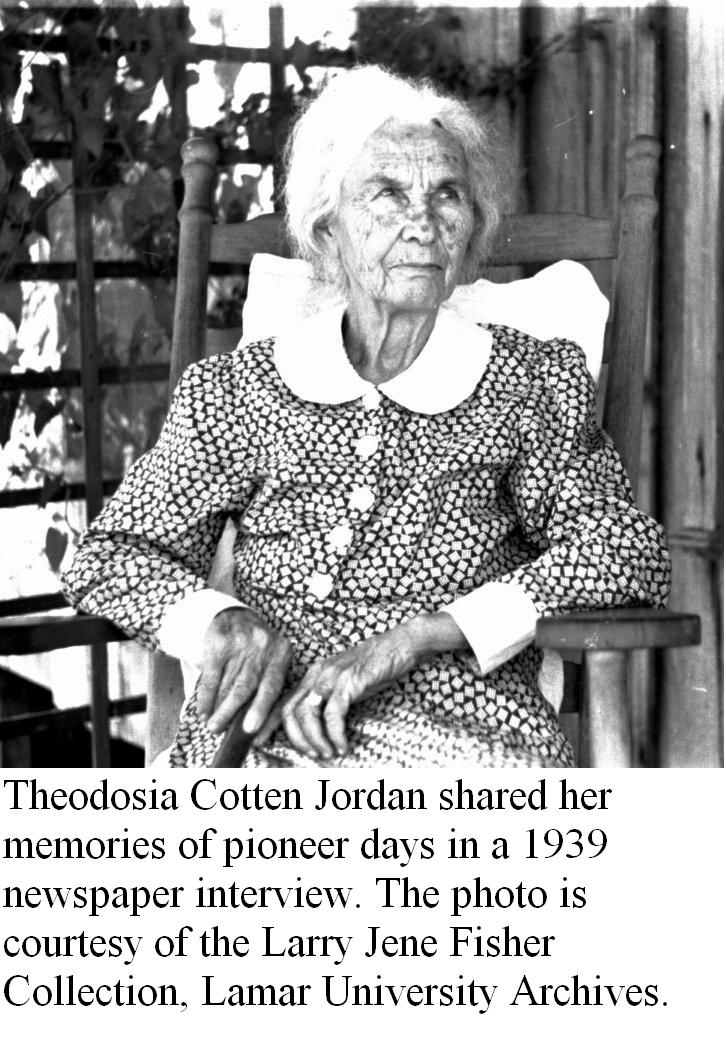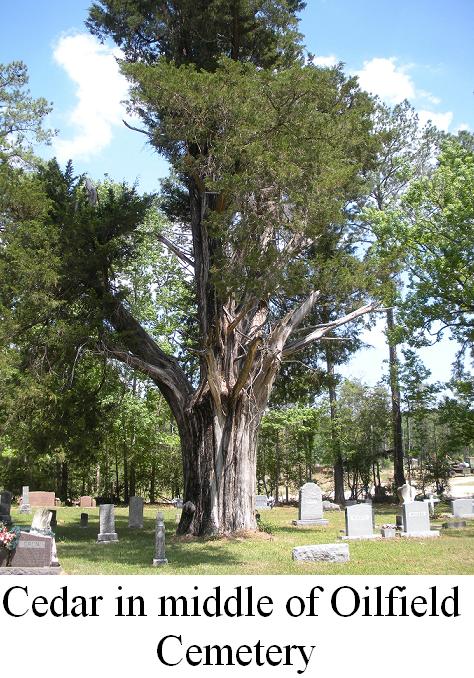By Renee Hart Wells
 A graveyard with an ancient cedar tree marks the location of an abandoned community in the old Saratoga oilfield. Located south of Hwy. 770 on Cotten Road, this is the resting place of the first Anglo family in the area- Elizabeth Granberry Hart Cotten, 1828-1889, and John Fletcher Cotten, 1819-1907.
A graveyard with an ancient cedar tree marks the location of an abandoned community in the old Saratoga oilfield. Located south of Hwy. 770 on Cotten Road, this is the resting place of the first Anglo family in the area- Elizabeth Granberry Hart Cotten, 1828-1889, and John Fletcher Cotten, 1819-1907.It was John Fletcher Cotten who tracked his muddy, tar-covered hogs through the woods to their oily wallow in 1860. There he found the medicinal springs and oil seeps known to the Indians of the Big Thicket. Cotten excitedly filed claim on 160 acres, cleared trees, built a small, rustic cabin and brought his wife Elizabeth and their eight children to the new home. Their daughter Theodosia later told of terrifying nights at that little cabin with the wild animals howling nearby.

Still following his dream, John Fletcher Cotten and a partner attempted to "pound in" an oil well on the family farm in the 1860s, using a mule and a heavy suspended weight. Although traces of oil and gas were found, the primitive equipment did not allow them to go deep enough to bring in the well, and Cotten gave up on the attempt.
Two of Elizabeth Cotten's sisters and their spouses--Mary Almira and Tom Jordan and Nancy and Richard Teel-made their homes nearby. Also, Epsye Hart, widow of Elizabeth's brother, joined them. Soon other families arrived to form a growing community. They built a school in 1870, which served as a church on Sunday, and started the cemetery at the western edge of the John F. Cotten Survey. Called J.F. Cotton or Jordan cemetery in the early days, by the 1890s the graveyard was known as Saratoga Cemetery since the area with its "soda springs" had been named for the resort in New York.
Cotten and others attempted to profit from these nearby springs by building campsites and a resort hotel, but wildcatters, drilling in the area after the gushers of oil at Spindletop, ended the resort business and started the Saratoga oil boom in 1901. Wooden derricks and tanks soon were almost as numerous as the trees had been 40 years before and quickly surrounded the farms, the little church, and the graveyard.
Many of the families moved out of the oilfield to "town" and the church and school also were moved to the new Saratoga townsite a short distance away. However, a number of people continued to bury their dead in the old graveyard, and when asked where a family member was to be buried, often now the reply was "down in the oilfield," thus the name, Oilfield Cemetery.
 With the decline in oil production years ago, the cedar tree in the cemetery has been joined by pines, oaks, and even a sycamore, possibly an offspring from one of the old farms. The cemetery is neatly kept and new markers join the beautiful old tombstones with their faded inscriptions and biblical motifs. Nevertheless, in close proximity today, renewed signs of the oil industry surround the graveyard, giving hopeful signs of prosperity around the old Oilfield Cemetery.
With the decline in oil production years ago, the cedar tree in the cemetery has been joined by pines, oaks, and even a sycamore, possibly an offspring from one of the old farms. The cemetery is neatly kept and new markers join the beautiful old tombstones with their faded inscriptions and biblical motifs. Nevertheless, in close proximity today, renewed signs of the oil industry surround the graveyard, giving hopeful signs of prosperity around the old Oilfield Cemetery.